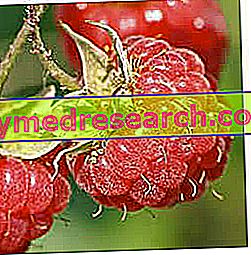Generality
European raspberries (in English raspberries ) belong to the group of "berries" and originate from the flowering of a shrubby plant belonging to the Rosaceae family, Genus Rubus, Species idaeus ; the binomial nomenclature of the European raspberry plant is therefore Rubus idaeus L.

NB . We can distinguish both varieties of raspberries characterized by uniform productivity (once a year, in late summer - early autumn), and varieties with biorefic productivity (in spring and autumn).
Like blackberries, raspberries are polidrupa fruits formed by the aggregation of several drupes on the same receptacle (convex) and belong to the category of aggregate or compound fruits; however, contrary to the blackberries that at full maturity take on a shiny black color, the raspberries maintain a red-opaque pigmentation (shade induced by the presence of bloom, a protective vegetable wax).
| Nutritional composition of Raspberry - Reference values of the INRAN Food Composition Tables | ||||||||||||||||||||||||||||||||||||||||||||||||||||||||||||||||||||||||
 | ||||||||||||||||||||||||||||||||||||||||||||||||||||||||||||||||||||||||
Nutritional values (per 100 g of edible portion)
| ||||||||||||||||||||||||||||||||||||||||||||||||||||||||||||||||||||||||
The CULTIVATED raspberries are generally forced to produce unifera (to increase the quality) late-summer and autumn, even if the relative maturation depends very much on the climate and the solar exposure of the plant; both with uniform and bi-productive productivity, raspberries always require great cultural extensions because they are characterized by a modest productivity.
Raspberries are sour and sweet fruits much appreciated by consumers of berries and widely sought after by phytotherapy lovers. In this regard, we recall that raspberries have diuretic properties and contain excellent amounts of vitamins (especially ascorbic acid), as well as phenolic substances (tannins and anthocyanins), all strongly antioxidant molecules, therefore anticancer. NB . In herbal medicine, raspberries, leaves and roots are also used to formulate infusions, decoctions and extracts with different functions on the organism.
Raspberries are consumed mainly fresh or frozen, but they make excellent jams and syrups. Extremely difficult to find but still present, the alcoholic beverage based on raspberries; it contains a rather modest alcoholic fraction (2-5%) and often (to increase fermentation) the must is strengthened with additional sugars.
Nutritional characteristics
Raspberries have an energy input that can be placed between that typical of less caloric fruits; they are composed mostly of water, which is around 85% of the total mass. Among the energetic macronutrients stand out simple carbohydrates (fructose - 5-7%), which mainly determine the energy supply. The free acids, responsible for the typical sour taste, the characteristic taste and aroma of raspberries, occupy 1.5% while the protein substances reach 2%. The cellulose fiber and the seeds represent 6% while the mineral substances 0.5% of the total weight of the raspberry.
Raspberry Sauce to Serve with Meat and Fish
X Problems with video playback? Reload from YouTube Go to Video Page Go to Video Recipes Section Watch the video on youtube



